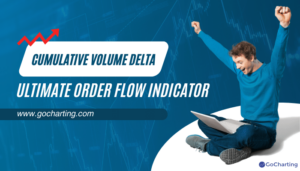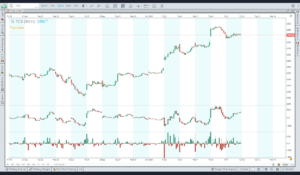
Volume Delta is a common technical analysis method used by traders in the forex, stock, and cryptocurrency markets to assess order flow. Volume Delta and Cumulative Volume Delta are two effective trading indicators that market players use to analyze order movement. The tools give real-time insights into a market’s buy and sell volumes and help you to identify probable reversals.
What Is Volume Delta in Trading?
Volume Delta is a common technical analysis method used by traders in the forex, stock, and cryptocurrency markets to assess order flow. Volume Delta is the differential between buying and selling pressure assessed by each candle and hence varies by time.
When the delta is positive, purchasing volume exceeds selling volume. A negative delta indicates that selling volume is greater than purchasing volume. When the purchasing and selling volumes are identical, the volume delta is 0 in some instances.
How To Analyze Volume Delta?
The gap between the volume delta and the zero line reflects the strength of buy or sell orders (positive or negative delta reading). Traders might search for divergences or utilize the volume differential to add confidence to their trade. Especially when comparing the volume delta to price movement.
A negative volume delta will increase a trader’s confidence in shorting. As it indicates that the market is more interested in selling than purchasing.
What Is the Cumulative Volume Delta?
Cumulative volume delta takes the delta values from each bar and puts them together to create a graph. It is found that price movement in any financial market is the outcome of buyer and seller supply and demand factors.
Cumulative Volume Delta can be used to identify market trend changes as well as to manage open transactions. Cumulative Volume Delta sums together delta readings. It produces an indicator that aids in the analysis of buying and selling pressure at important swing highs and lows.

Cumulative Volume Delta: How To Spot Trend Shifts?
When you compare the cumulative volume differential to market structure, you will observe that they both point in the same direction.
When the high attained on a securities is higher than the price activity surrounding it, a swing high (SH) occurs. A new swing high is produced when price climbs above a previous swing high and begins to retrace. When the low hit on a security is lower than the price activity surrounding it, a swing low (SL) occurs. A new swing low is produced when price falls below a previous swing low and begins to retrace.
CVD shows the cumulative Delta value beneath the price chart by summing the Delta values of each price bar. If the Delta value is larger than zero, it means that purchasing pressure outnumbers selling pressure, and the price may climb. If the Delta value is less than zero, selling pressure is stronger than purchasing pressure, and the price may decline. It can also be zero if the purchasing and selling volumes are the same.
Also Read : Key Indicators for Order Flow Trading: Identifying Market Sentiment
How To Use Cumulative Volume Delta in Trading?
Cumulative Delta Volume is a method of measuring an asset’s mid- to long-term purchase and sell pressure using Delta. It analyses purchasing and selling volume over time. It provides insights into market behavior at various price points.
Cumulative volume delta takes the delta values for each bar and adds them up sequentially to produce a graph. If the cumulative market volume delta rises and exceeds zero. It indicates that buyers are more eager to trade into the offer than sellers are to hit the bid. If we are below zero and falling, sellers are more inclined to meet the bid and pay the current market price.
Cumulative Volume Delta and Trade Management
CVD may give valuable reference data to traders while making trading choices. Traders can utilise CVD to evaluate the market’s general trend and to confirm market bottoms and peaks. Furthermore, CVD may be used to manage trading positions. Traders can use the high correlation between price and CVD while holding positions. It determines whether the market has strong buying or selling power. If the price rises or falls to a new high or low, but CVD does not follow, it might indicate a market reversal.
Rather than leveraging absorption and fatigue to drive fresh trades, you should look for these indicators to possibly exit current investments.
Cumulative Delta Indicators
There is just one place to go if you are interested in using a cumulative delta indicator in your crypto trading. One of the greatest indicators is GoCharting. Many traders prefer to use it to analyse the cumulative volume delta because they believe it has access to more reliable data. It is essential to decide which platform you like for yourself.
Also Read : Comparison of Bookmaps with Footprints, Volume Profiles, and DOM
Final Verdict
Volume Delta is a technical analysis approach used to measure order flow by traders in the forex, stock, and cryptocurrency markets. It is the difference between buying and selling pressure calculated for each candle and fluctuates with time. Cumulative Volume Delta (CVD) is a way of employing Delta to calculate an asset’s mid- to long-term buy and sell pressure.
GoCharting, which provides more trustworthy data, is one of the greatest indicators for analysing CVD. Traders should consider utilising GoCharting for the use of CVD in crypto trading.
Frequently Asked Questions
1. What is the cumulative delta bar volume?
Volume is a trading measure that tracks the difference between buying and selling volume over a given timeframe or for individual price bars. It keeps track of the volume traded at ask (buying) and bid (selling) prices, which helps traders analyse market sentiment and order flow.
2. What are the cumulative volume delta candles?
Candles are graphical representations of trade volume. Each candlestick on such a chart represents the cumulative volume differential for a certain time period, often representing the net buying or selling volume during that time period. These charts are used to analyse the dynamics of order flow and identify probable trend reversals.
3. What is the difference between Delta and cumulative volume Delta?
The distinction between Delta Volume and Cumulative Volume Delta can be seen in their temporal perspectives. Delta is used to describe the instantaneous difference between purchasing (ask) and selling (bid) volume at a certain point in time, providing insights into short-term market sentiment. Cumulative Volume Delta, on the other hand, aggregates these deltas over a specified time period, providing a longer-term picture of order flow trends and overall market dynamics.
4. How is cumulative volume calculated?
Cumulative Volume is calculated by adding the volume of each trade within a given time frame or beginning point. Cumulative Volume Delta is calculated by subtracting the cumulative selling volume from the cumulative buying volume. This continuous computation produces an ongoing total of net volume transacted at different price levels or within particular time intervals.